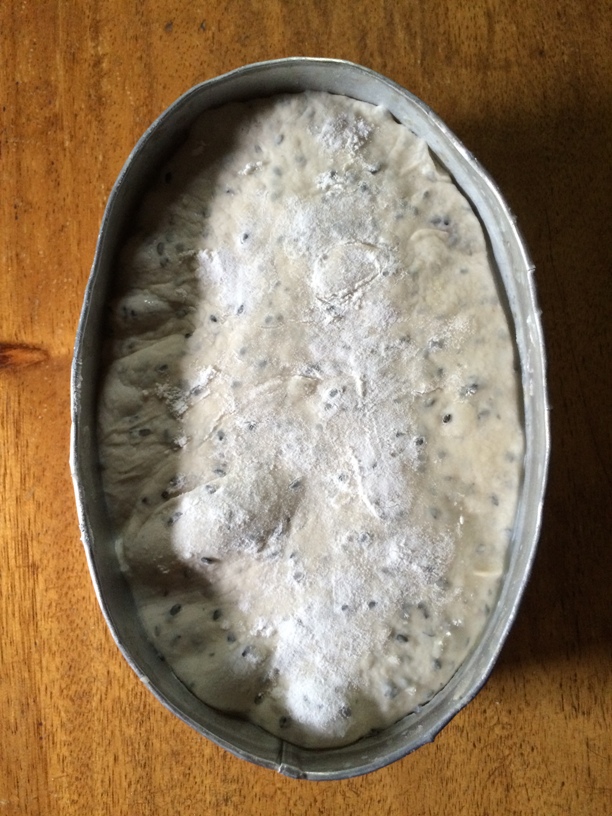I think, I finally figured out the best method for baking lean breads in my clay pot so it's time to move to "flavor" aspect of the bread. I refrained from putting flavors in the bread because the cooking method is my focus so I want to change that only variable every experiment, that's why for so long we're only eating white lean loaves. For a start, I chose a common ingredient that I have that seems to be a classic flavor/addition to breads; sesame! It's amazing that a little amount of a single ingredient gives the bread an explosion of flavor. I've seen many folks here did it and here is my best so far. I've used black sesame to add color; toasting them is more difficult because you cannot judge them by color like white ones so I always do the "sniff" and "crush" tests.

The dough right after shaping.
I've used 50/50 AP/BF again because the last breads with only BF came out too chewy for me. Inspired by Bouabsa's baguettes and Reinhart's pain a l'ancienne, I mixed chilled flour, ice water, salt, instant yeast and sesame seeds; every fermentation stage is done in the fridge except for the final proof, 3 S&F's every 2 hours after 5 hours in the fridge and a pre-shape with overnight rest. In the morning, I shaped the dough into a batard and proofed it seam-side down in my oiled and lined "giant" llanera for 2.5 hours since it's pretty cool here today.

The dough fully proofed.
I let the dough dry a little bit in the fridge for 10 minutes before scoring because the air there is pretty dry. It is then baked for for 50 minutes in the pot; the first 10 minutes with steam, flipped after 30 minutes for the top crust to brown for the last 20 minutes.

Scoring is not so good and difficult when in a pan like this.
I totally forgot not to score the middle so the score marks won't be squished when I flip the bread so I just proceeded to bake it (next time I will surely remember it), as result the score is negligible in the final bread. I'm also not still used to scoring wet doughs so I have to practice more. Steaming is not a problem in the pot, the water it absorbs when washed before baking is enough to generate steam for the appropriate time. The bread rose well in the pot too.

I was greeted by this beauty when I released the steam.
When I flipped the bread (this is a combination of methods no. 2 and 5 as I've said before in my older post) onto a smaller llanera, I didn't noticed that it slipped and had direct contact with the pot itself. When I came back, it was browned but charred in some areas, if it did not happened this bread would be even more gorgeous.

It's the largest loaf my loaf (8 inches long) my pot can handle but it's only as big as my hand!


Crumb is pretty tight for a wet dough, any thoughts why? Maybe because of poor shaping/too much handling; OR the dough failed to expand to its fullest because the pan is restraining it but I think it helps support the structure of the bread and I can clearly see that. It is identical to what happened in method no. 2 in the previous post.

The crust up-close, full of sesame seeds!

Crust is thin and very crispy when it came out of the pot but became soft and chewy when it cooled, crumb is moist, soft and chewy; full of sesame fragrance and flavor which is pronounced but not overpowering, just right. The black sesame contrasts nicely with the creamy crumb, very pretty!

Though there are still lots of improvements to be made, I'm very happy with how this loaf turned out; one of the most beautiful lean bakes I made. My mom and dad said that for a leavened bread baked without an oven using only a pot, this is very beautiful and can be called exceptional; they always encourage and support me.
I'm so excited to try more flavor combos (my own crazy ones and those tested/formulated by fellow bakers), grains and add- ins in the future! I think my next one will be even better!
-----------------------------------------------------------------------------------------------------------------------------------------------------
Remember my red bean paste in my last post? It's all gone now and I've used it in a number of treats. After this, it may take a while again for me to bake/cook something. If I'm not in the mood to cook, you can't force me; but when I'm on it almost nothing can't stop me be it an exotic ingredient, heat, storm, lack of sleep or anything!
I made this little crepes yesterday and filled them with the bean paste. I thought of making dorayaki but I settled on this crepes for something different. Too bad, they're almost gone when I snapped a photo.


I also made Bukkumi today while the bread was cooling, of course filled with my bean paste! It is a traditional Korean pan-fried rice cake filled with a sweet filling. I also garnished them the black sesame seeds, very pretty! I made it so I can have a sticky rice-bean combo, sticky rice and bean pastes always go well together, so delicious! Nice change from the usual fried sesame balls and steamed rice cakes. By the way, if I only had some nice strawberries I could have even made Ichigo Daifuku.


Another tiring but fun-filled day! Till my next cooking/baking adventure!
Thank you very much!